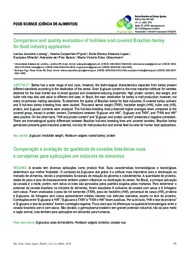Comparison and quality evaluation of hull-less and covered Brazilian barleyfor food industry application.
Comparison and quality evaluation of hull-less and covered Brazilian barleyfor food industry application.
Author(s): LUDWIG, L. J.; CARPENTIERI-PIPOLO, V.; LOPES, K. B. A.; MINELLA, E.; BELEIA, A. D. P.; GROSSMANN, M. V.
Summary: Barley has a wide range of end uses. However, the technological characteristics expected from barley present different standards according to the destination of the cereal. Grain β-glucan content is the most important attribute for varieties destined for the food market due to blood glucose and cholesterol-reducing properties. High protein content, test weight, and huller rate may also add value to different end uses. In Brazil, the main destination for barley is malt production; however, not every lot achieves malting standards. To determine the quality of Brazilian barley for food industries, 9 covered barley cultivars and 8 hull-less barley breeding lines were studied. Thousand kernel weight (TKW), hectoliter weight (HW), huller rate (HR), protein, and β-glucan contents were analyzed. The hull-less breeding lines presented higher averages when compared to the covered group, except in protein content. Correlations between ?β-glucan and HW?, ?β-glucan and TKW?, and ?TKW and HW? were positive. On the other hand, ?HW and protein content? and ?β-glucan and protein content? presented a negative correlation. There are bromatological quality differences between Brazilian hull-less breeding lines and covered varieties. Brazilian barley germplasm presents great industrial potential, not only for malt production and animal feed but also for human food applications.Key words:β-glucan; hectoliter weight, Hordeum vulgare; naked barley; protein
Publication year: 2019
Types of publication: Journal article
Unit: Embrapa Wheat
Keywords: ?-glucan, Hectoliter weight, Hordeum Vulgare, Naked barley, Protein
Observation
Some of Embrapa's publications are published as ePub files. To read them, use or download one of the following free software options to your computer or mobile device. Android: Google Play Books; IOS: iBooks; Windows and Linux: Calibre.
Access other publications
Access the Agricultural Research Database (BDPA) to consult Embrapa's full library collection and records.
Visit Embrapa Bookstore to purchase books and other publications sold by Embrapa.

